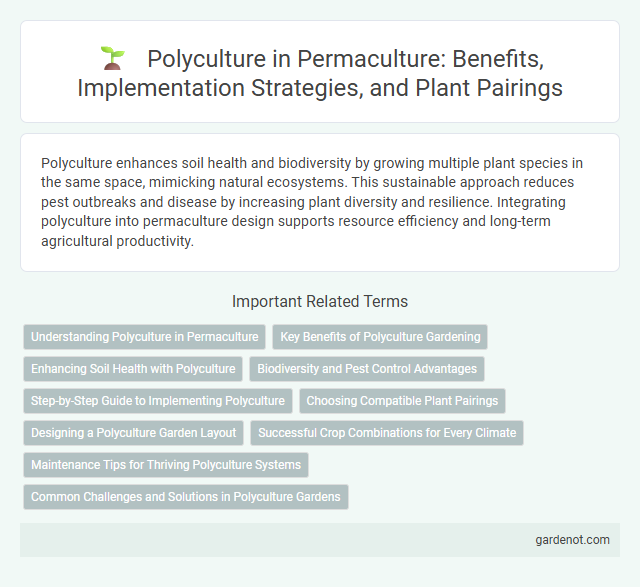Polyculture enhances soil health and biodiversity by growing multiple plant species in the same space, mimicking natural ecosystems. This sustainable approach reduces pest outbreaks and disease by increasing plant diversity and resilience. Integrating polyculture into permaculture design supports resource efficiency and long-term agricultural productivity.
Understanding Polyculture in Permaculture
Polyculture in permaculture emphasizes cultivating multiple crop species simultaneously to enhance biodiversity, improve soil health, and optimize resource utilization. By mimicking natural ecosystems, polyculture systems reduce pest outbreaks and increase resilience against environmental stresses. Integrating complementary plants like legumes, cereals, and root crops fosters nutrient cycling and sustainable food production.
Key Benefits of Polyculture Gardening
Polyculture gardening enhances biodiversity by cultivating multiple plant species together, improving soil fertility and reducing pest outbreaks naturally. This sustainable approach optimizes space and resource use, leading to increased crop resilience and higher yields compared to monoculture systems. Integrating complementary plants supports ecological balance and promotes long-term garden health.
Enhancing Soil Health with Polyculture
Polyculture enhances soil health by promoting biodiversity, which improves nutrient cycling and supports beneficial soil microorganisms. Diverse plant roots increase organic matter and stimulate microbial activity, leading to better soil structure and fertility. Integrating multiple species also reduces soil erosion and minimizes pest outbreaks, creating a resilient agroecosystem.
Biodiversity and Pest Control Advantages
Polyculture in permaculture enhances biodiversity by cultivating multiple plant species simultaneously, creating a resilient ecosystem that supports beneficial insects and wildlife. Diverse plant arrangements disrupt pest life cycles, reducing the reliance on chemical pesticides through natural pest control mechanisms. This balance fosters healthier soil, improved pollination, and sustained crop productivity.
Step-by-Step Guide to Implementing Polyculture
Start by selecting a diverse range of compatible plant species that fulfill various ecological functions such as nitrogen fixation, pest control, and soil enrichment. Prepare the soil by adding organic compost and mulch to enhance fertility and moisture retention, then arrange plants in spatial patterns that maximize sunlight exposure and encourage natural pest barriers. Regularly monitor plant health and biodiversity, adjusting species composition and planting density to maintain ecosystem balance and optimize yield.
Choosing Compatible Plant Pairings
Selecting compatible plant pairings in polyculture enhances soil health, pest control, and overall yield by mimicking natural ecosystems. Complementary species like nitrogen-fixing legumes with nutrient-demanding crops optimize resource use and reduce the need for synthetic fertilizers. Strategic plant combinations such as corn, beans, and squash, known as the "Three Sisters," exemplify effective polyculture by improving nutrient cycling and providing mutual support.
Designing a Polyculture Garden Layout
Designing a polyculture garden layout involves strategically planting diverse species that complement each other's growth patterns, nutrient needs, and pest resistance. Incorporate layers such as ground cover, mid-height shrubs, and taller trees to maximize space and promote biodiversity, enhancing soil health and ecosystem resilience. Effective polyculture design also integrates companion planting principles, ensuring plants support each other for optimal yields and reduced pest outbreaks.
Successful Crop Combinations for Every Climate
Polyculture systems enhance biodiversity and resilience by integrating complementary crop species that optimize nutrient use and pest control in diverse climates. Successful crop combinations, such as maize with beans and squash in temperate regions or millet with cowpeas in arid zones, improve yield stability and soil health. Tailoring polyculture to local environmental conditions maximizes productivity while supporting sustainable permaculture practices.
Maintenance Tips for Thriving Polyculture Systems
Thriving polyculture systems require regular monitoring of plant health to identify pests and diseases early, reducing the need for chemical interventions. Incorporating diverse species with complementary growth habits enhances soil fertility and pest control, while proper spacing ensures adequate light and airflow. Mulching and organic compost applications maintain soil moisture and nutrient levels, supporting robust plant growth throughout the seasons.
Common Challenges and Solutions in Polyculture Gardens
Polyculture gardens often face challenges such as pest management, nutrient competition, and uneven crop growth due to the diversity of plant species. Integrated pest management techniques and the use of companion planting can significantly reduce pest outbreaks and improve biodiversity balance. Implementing crop rotation and soil testing allows gardeners to optimize nutrient availability and ensure healthy plant development in polyculture systems.
Polyculture Infographic

 gardenot.com
gardenot.com